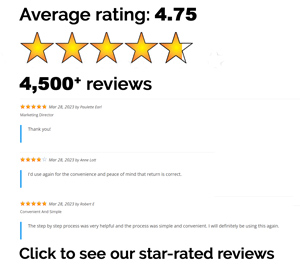The information in this article is up to date for tax year 2023 (returns filed in 2024).
It’s easy to overlook opportunities to save when you’re not familiar with the ins and outs of taxes. And the consequences are costly. Missing out on valuable tax breaks can result in you getting a smaller tax refund than you deserve, or even worse, owing the IRS. Sounds awful! To help you get your maximum refund, we’re pointing out some tax breaks filers commonly ignore, so you don’t miss out on savings.
What is a tax break?
A tax break is any tax law that gives you the opportunity to reduce your tax bill. They usually come in the form of tax credits, tax deductions, tax exemptions, or exclusions of certain types of income. Tax breaks are typically created by the government to encourage specific social or economic behaviors.
The Child Tax Credit can get you up to $2,000 per child
Welcomed a new bundle of joy into your family last year? Congratulations! You’re about to have even more to reason celebrate because you’re now eligible for the Child Tax Credit. It is can reduce your tax bill by up to $2,000 for each qualifying child under the age of 17. You may also be able to receive a partial refund of $1,600 through the Additional Child Tax Credit.
| Note: Lawmakers are currently working to increase the refundable portion of the Child Tax Credit to $1,800 for tax year 2023, $1,900 for tax year, and $2,000 for tax year 2025. If the bill passes, the IRS will automatically issue any additional refunds within 6 to 12 weeks, so there’s no need to delay filing. For those who have already filed, no further action is required from you. |
Save up to $2,500 with the American Opportunity Tax Credit
Between tuition, books and fees, going to college costs an arm and a leg. Fortunately, your expenses can help you qualify for an education credit to lower your tax bill. If you’re an undergraduate student, you may be able to claim the American Opportunity Tax Credit which is worth up to $2,500 and is partially refundable. That means if you’ve paid all the necessary taxes and some of the credit is leftover, you can get up to 40% (or $1,000) as a refund. Doing your taxes can be fast, ez and stress-free. File with ezTaxReturn now and we’ll guide you every step of the way.
Workers can get over $7,000 through the Earned Income Tax Credit (EITC)
The Earned Income Tax Credit (EITC) ranges from $600 to $7,430 depending on how much you make, the number of kids you claim and your filing status. Generally, those with larger families get a higher credit amount. Smaller families or single individuals with no kids can claim the EITC, but don’t expect to receive the maximum credit. The income limits are as follows:
Single, head of household or widowed
- $56,838 with three or more qualifying children
- $52,918 with two qualifying children
- $46,560 with one qualifying child
- $17,640 with no qualifying children
Married filing jointly
- $63,398 with three or more qualifying children
- $59,478 with two qualifying children
- $53,120 with one qualifying child
- $24,210 with no qualifying children
Your investment income must also be less than $11,000 for the year.
Your childcare expenses can help you get a tax break
Paying for childcare can take a big bite out of your budget. Fortunately, you may be able to claim the Child and Dependent Care Credit to recoup some of the costs when you do your taxes. How much can you claim for the Child and Dependent Care Credit? For tax year 2023, working parents can claim up to $3,000 in childcare expenses for one qualifying child and $6,000 for two or more qualifying children. The maximum credit is 35% of your expenses. To qualify, your dependent must be 12 or younger or a dependent or spouse of any age who is incapable of taking care of themselves. Your dependent must also live with you for at least half of the year.
Charitable donations are tax-deductible
Giving to those in need makes you feel good and can help you save money on your taxes. Whether you volunteer, give cash, or donate property to a qualified organization, your charitable contribution may be tax deductible. But you must itemize to claim the deduction. Keep in mind that if you donate $250 or more, you must get a receipt from the organization. For more information on how to claim a deduction on charitable contributions, check out IRS Publication 526.
You can claim gambling losses
When it comes to gambling, you win some and you lose some. The IRS doesn’t care whether your prize money comes from a lottery ticket, horse race or the casino, they expect you to report your winnings on your tax return. But what you probably don’t realize is that if you itemize, you can deduct your gambling losses. The only drawback is that it cannot exceed the amount of your winnings. So, if you won $500, but lost $800, you can only deduct $500 of your losses.
Up to $300 of educator expenses are tax-deductible
It’s not uncommon for teachers to dig into their own pockets to ensure their students have everything they need. And your generosity will pay off at tax time. Educators are allowed to deduct up to $300 of unreimbursed expenses. Qualified expenses include professional development courses, books, supplies computer equipment, and items that prevent the spread of Covid-19. Make sure to save your receipts if you plan to take the Educator Expense Deduction.
The Saver’s Credit is available for taxpayers saving for retirement
Taxpayers who contribute to a retirement plan, deferred compensation plan or an IRA, may be able to claim the Saver’s Credit on their federal tax return. To qualify you must be:
- At least 18 years old
- Not a full-time student, and
- Not listed as a dependent on someone else’s tax return.
Your adjusted gross income also cannot be more than:
- $73,000 if you’re married filing jointly,
- $54,750 if you’re head of household, or
- $36,500 if you’re single, married filing separately, or a qualifying surviving spouse.
The maximum credit is $1,000 ($2,000 for married couples filing jointly) for eligible filers.
Health Savings Accounts (HSAs) offer a triple-tax advantage
If you have a high-deductible health plan, opening a health savings account (HSA) can help you cover medical expenses more easily and lower your tax bill. An HSA lets you save pre-tax dollars to pay for medical expenses not covered by your insurance. The money you save lowers your taxable income, so you pay less taxes. Your money grows tax-free, and your withdrawals are tax-free when used for eligible medical expenses. The 2023 HSA contribution limit is $3,850 for individual coverage and $7,750 for family coverage. Once you turn 55, you have the option of contributing an additional $1,000. The deadline to make contributions for 2023 is April 15, 2024.
With ezTaxReturn, you can file with confidence knowing that you’re getting the biggest possible refund, guaranteed.
The articles and content published on this blog are provided for informational purposes only. The information presented is not intended to be, and should not be taken as, legal, financial, or professional advice. Readers are advised to seek appropriate professional guidance and conduct their own due diligence before making any decisions based on the information provided.




